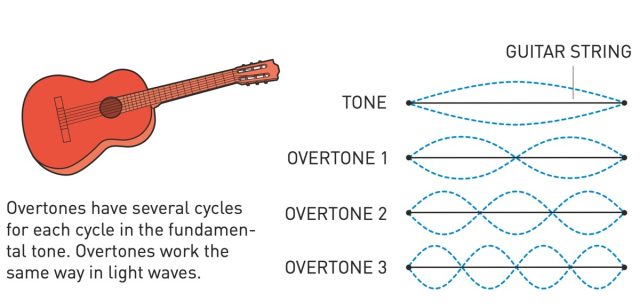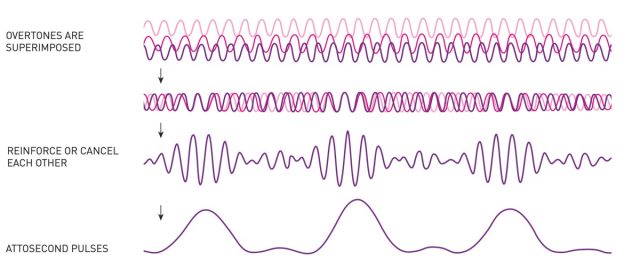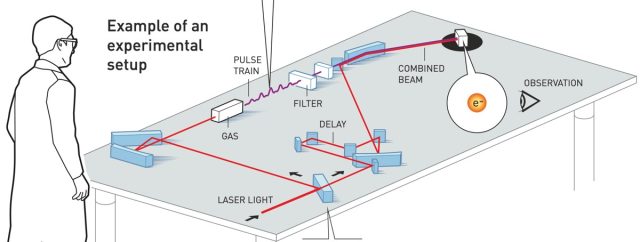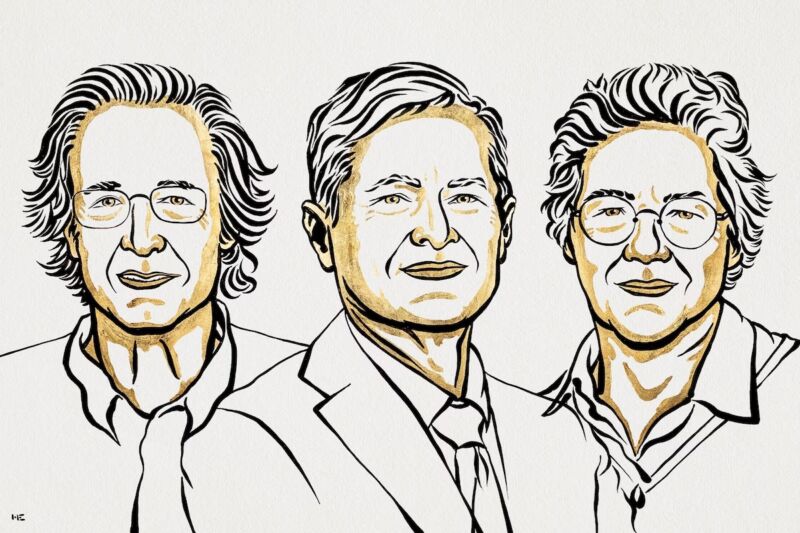Pierre Agostini, Ferenc Krausz, and Anne L'Huillier honored for attosecond spectroscopy
Electrons move and change energies at such a blistering speed that physicists long believed it would never be possible to capture their dynamics, even with the fastest lasers. The Royal Swedish Academy of Sciences has awarded the 2023 Nobel Prize in Physics to three scientists who used ultrafast pulses of light to do just that with a technique known as attosecond spectroscopy. Per the citation, Pierre Agostini, Ferenc Krausz, and Anne L'Huillier "have given humanity new tools for exploring the world of electrons inside atoms."
It's well known that to capture detailed images of, say, a hummingbird mid-flight, one needs to use exposure times that are shorter than a single beat of the hummingbird's wings. But atoms in a molecule move in billionths of a second, aka femtoseconds; electrons move and change energies faster, between one and a few hundred attoseconds. (An attosecond is one billionth of a billionth of a second.) If you sent a flash of light from one end of a room to the other, it would take 10 billion attoseconds. Physicists had long believed that a femtosecond was the fundamental limit for producing short bursts of light—at least with existing technology—and thus capturing the behavior of electrons in atoms was beyond reach.
That changed over the last 20 years. “The ability to generate attoseconds of light has opened the door on an extremely tiny timescale, and it also opened the door to the world of electrons,” said Eva Olsson, chair of the Nobel committee for physics, at the press conference announcing the prize. “Back in 1925, Werner Heisenberg argued that this world cannot be seen. Thanks to attosecond physics, this is now starting to change.” The work is expected to have a significant impact on electronics, where understanding and controlling how electrons behave in materials is critical to achieving faster electronics, as well as in medical diagnostics, which requires being able to identify different molecules.

An attosecond is to one second as one second is to the age of the universe.
Johan Jarnestad/The Royal Swedish Academy of Sciences
The scientific foundation for this year's prize arose from L'Huillier's 1987 experiments transmitting infrared laser light through a noble gas. Any kind of waveform can be constructed by combining various waves of the right sizes, wavelengths, and amplitudes; to get a waveform capable of capturing an electron's movements on an atomic scale, one needs to combine lots of very short wavelengths. It's impossible to do this with just a laser, but L'Huillier's lab discovered that passing the laser light through a gas will lead to interactions with the atoms in the gas.
This results in overtones, akin to the overtones of sound waves produced by a guitar or piano. The overtones then interact with each other, and under just the right circumstances, those overtones can be "in phase"—that is, the peaks of their waves line up in such a way that they reinforce each other, making the laser light more intense and producing pulses just a few hundred attoseconds long.
Now at Lund University in Sweden, L’Huillier is only the fifth woman to receive the Nobel Prize in Physics in the Academy's 122-year history of awarding it. She was lecturing to students when her phone kept ringing; eventually, she answered to hear the life-changing news—and then kept right on teaching. (Students and colleagues at Lund lined up to cheer for the newly minted laureate afterward.) “The last half hour of my lecture was difficult to do,” she said during the Nobel news conference. “I am very touched at the moment. As you know there are not so many women who get this prize, so it’s very, very special.”

Johan Jarnestad/The Royal Swedish Academy of Sciences
Physicists developed the theoretical framework for L'Huillier's experiments in the 1990s, but it wasn't until 2001 that scientists experimentally identified and tested the attosecond pulses. Agostini—now at Ohio State University—was working in France at the time, and he and his research group figured out how to create a series of consecutive attosecond pulses of light—a kind of "pulse train." They divided the laser beam in two, using one to create the pulse train. Then they added the pulse train to the original laser pulse. Ultimately, they produced consecutive pulses of light lasting just 250 attoseconds each. Today, it's possible to produce a train of pulses lasting 50 attoseconds.
The Academy couldn't reach Agostini by telephone to inform him he had won the Nobel Prize; he learned about it through the grapevine. “My daughter called me asking, ‘Is that true, I see it on Google?’" he said. "I thought it was some kind of mistake." And then, when the news was confirmed, "I thought of going away far from any telephone," he said. "Why they chose to award this kind of research now is sort of a mystery. It's a long time for me, about 20 years since we did that experiment. But better late than never."

Johan Jarnestad/The Royal Swedish Academy of Sciences
Also in 2001, Krausz's research group in Austria figured out how to select and isolate a single pulse lasting 650 attoseconds out of the pulse train, akin to decoupling one car and switching it to another track. They used that isolated pulse to track and study how electrons pull away from their atoms. Now at the Max Planck Institute of Quantum Optics, Krausz is the second Hungarian to win a Nobel Prize this week. Katalin Karikó shared the 2023 Nobel Prize in Physiology or Medicine (announced yesterday) with Drew Weissman for showing that chemical modifications to the molecular building blocks of messenger RNA (mRNA) could enable its use for therapeutics and vaccines—a realization crucial to the rapid development of the life-saving mRNA COVID-19 vaccines during the deadly pandemic.
Krausz was preparing for a busy morning of conducting lab tours for visitors at his institute when he received the news. "I was not sure whether I was dreaming or whether it was reality," he said in a post-announcement phone call with the Academy. "It's still a question that I have to clarify with myself." He also gave credit to friends and colleagues who had contributed either directly or indirectly to his achievement. "I feel a great deal of gratitude to all of them," he said. "Without their contributions, without really concerted research efforts throughout my career, this just wouldn't have been possible."

The laser light is divided into two beams, where one is used to create a train of attosecond pulses. This pulse train is then added to the original laser pulse, and the combination is used to perform extremely rapid experiments.
Johan Jarnestad/The Royal Swedish Academy of Sciences
Attosecond pulses essentially opened a new "time window" for physicists, enabling them to explore and potentially answer fundamental questions that weren't previously feasible. For instance, attosecond spectroscopy has been used to measure how long it takes for an electron to free itself from an atom—depending on how tightly it's bound to the nucleus—and to reconstruct the changing positions of electrons in molecules and materials. In fact, it's now possible to explore the timescale involved in the photoelectric effect, for which Albert Einstein won the Nobel Prize in Physics in 1921.
“This work is truly groundbreaking. Attosecond laser pulses reveal the hidden world of electron dynamics within atoms and molecules,” said Michael Moloney, CEO of the American Institute of Physics, in a statement. “These techniques help us peer inside atoms to the scale of electrons, which were previously moving too fast for us to see—we didn't have a strobe light fast enough to resolve the motion. This new window into the natural world allows us to probe electron dynamics in atomic and molecular systems, which are at the heart of the chemical and physical interactions of materials that underpin all our electronic, chemical, and medical innovations and technology.”
Source



3175x175(CURRENT).thumb.jpg.b05acc060982b36f5891ba728e6d953c.jpg)





Recommended Comments
Join the conversation
You can post now and register later. If you have an account, sign in now to post with your account.
Note: Your post will require moderator approval before it will be visible.